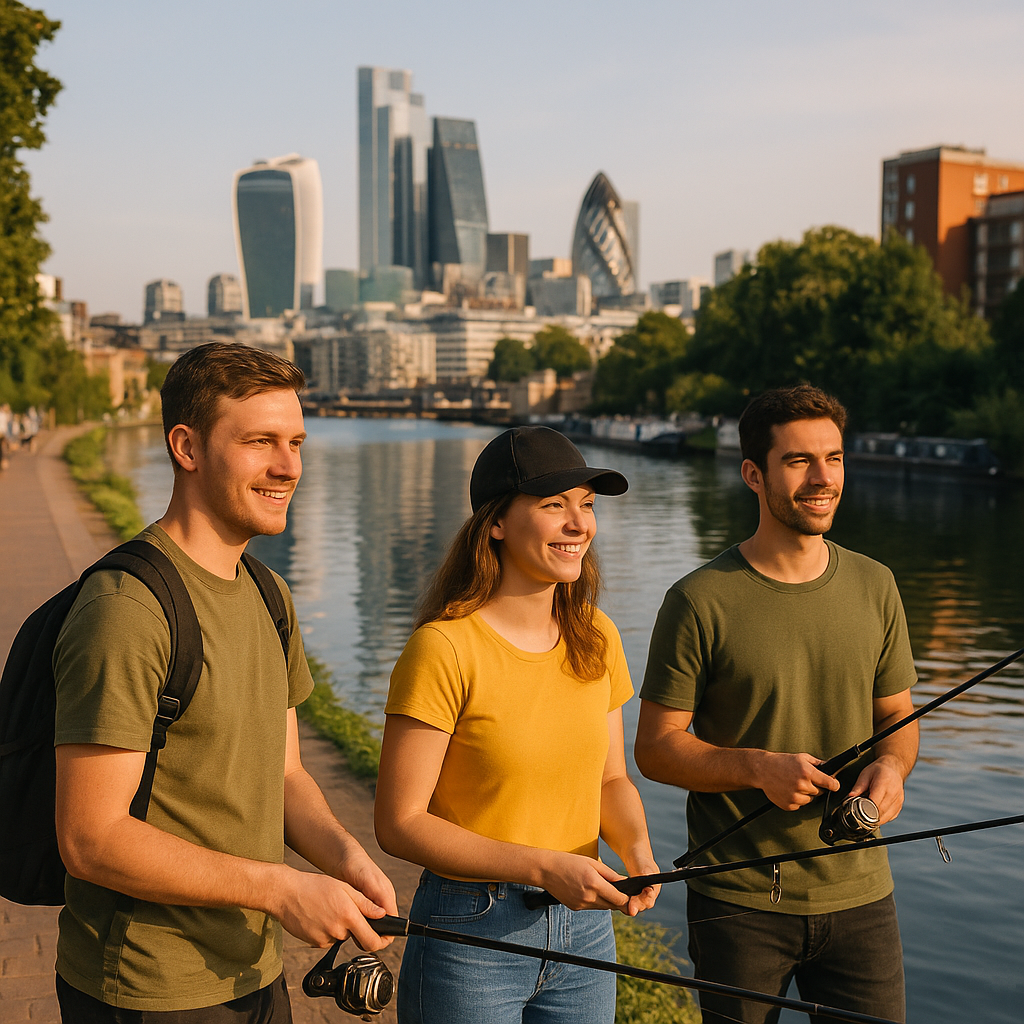In recent years, a quiet revolution has been taking place along Britain’s urban waterways. City workers armed with compact rods are reclaiming lunch breaks, young people are discovering the mindful art of fishing, and social media is awash with hashtags like #streetfishing. Welcome to the world of urban angling – one of the UK’s fastest-growing outdoor activities.
The Urban Fishing Boom: Why Now?
The numbers don’t lie – with nearly one million rod licenses sold in 2023/24 and participation climbing steadily since the pandemic, urban fishing has firmly established itself in Britain’s recreational landscape. But what’s driving this surge?
Health and Wellbeing Benefits
In our hyperconnected, always-on world, fishing offers a rare chance to disconnect and be present. An overwhelming 99% of anglers agree that fishing benefits their mental health, according to government surveys. Post-pandemic, many new participants cited “reconnection with nature” as their primary motivation, with fishing offering both mindfulness and the perfect socially-distanced outdoor activity.
Even the NHS has begun experimenting with “prescribing” fishing for mental health support – a testament to its therapeutic potential.
A New Generation Redefines the Sport
Forget the stereotypical image of older men sitting motionless by murky ponds. Today’s urban anglers are diverse, mobile, and socially connected. “Street fishing” – a lure-based approach perfect for city canals and rivers – has particularly captured the imagination of younger generations.
Influencers and brands like Fox Rage, URBN, and Spro Freestyle have transformed fishing’s image, making it cooler and more accessible. Social media plays a huge role too, with fishing videos gaining massive traction on platforms like TikTok.
Accessibility and Convenience
Perhaps the most compelling aspect of urban fishing is its sheer convenience. Millions of city workers are now within a short walk of a waterway – the Canal & River Trust reports that 2.5 million people work within 250m of a canal or river.
With minimal equipment needed – just a compact rod, light spinning gear, and simple bait – new anglers can get started quickly and affordably. As one London angler put it, you can “bring a little fold-up rod” to work and catch a fish in “half an hour” during your lunch break.
What You’ll Catch: Urban Species
The UK’s urban waterways host a surprising diversity of fish. In canals and city rivers, you’ll commonly find:
Coarse fish: Roach, rudd, tench, bream, and carp are widespread
Predator species: Perch dominate many city canals, while pike lurk under bridges and near structures
Invasive species: Zander have established themselves in many murky, low-visibility canals
Fish populations vary with water quality and boat traffic. Quieter canals with clear water and vegetation yield more diverse catches, while busier waterways might primarily produce roach and gudgeon.
One of urban fishing’s greatest appeals is its unpredictability – as one angler noted, “you never know what you’re going to catch” beneath a city bridge!
Top Urban Fishing Spots in the UK
Nearly every major UK city offers productive fishing. Here are some standout locations:
London
Regent’s Canal: The centerpiece of London street fishing, hosting perch, big roach, and pike
Grand Union Canal (Little Venice/Paddington): An “urban haven” for predators, with big perch and 5-10 lb pike
Birmingham
Soho Loop (Birmingham Canal Navigations): Despite being in the heart of the city, anglers here report pike over 15 lb and 3 lb-plus perch
Nottingham
River Trent (City Centre): The Embankment area is a perch and pike hotspot in winter
Norwich
River Wensum: This classic urban river holds large shoals of coarse fish and winter predators
Manchester
Manchester Ship Canal (Salford/Salford Quays): Though industrial, parts near Salford Quays produce zander, perch, and occasional large pike
Other noteworthy locations include city canals in Glasgow and Edinburgh, the River Tyne in Newcastle, and urban stretches of the Trent and Mersey Canal around Stoke and Stafford.
Getting Started: Gear for Urban Fishing
Urban anglers favor light, portable setups that can be easily transported and used in confined spaces:
Rods: Short “pack-away” rods around 7-8 feet in length
Reels: Light spinning reels loaded with braided line
Lures: Small spinners, soft plastics, and crankbaits are popular for predator fishing
Accessories: Many carry just a backpack of lures, ready to hop between spots
This minimalist approach makes urban fishing particularly accessible to beginners – no boat, heavy tackle box, or expensive gear required.
Rules and Regulations
While urban fishing is accessible, you’ll still need to follow the standard UK angling regulations:
Rod License: Anyone 13 or older fishing in freshwater needs a valid rod license (£33 for a 2-rod coarse license in 2023/24, rising to about £36.60 by 2025)
Access Rights: On canals managed by the Canal & River Trust, you’ll typically need either:
Membership in the local angling club that controls that stretch, or
A CRT “Waterway Wanderers” permit
Catch and Release: Virtually all urban anglers practice catch-and-release. As one article notes: “everything caught goes back into the water – all recreational freshwater fishing in the UK is ‘catch and release’.”
\The Future of Urban Fishing
With initiatives like the Angling Trust’s “We Fish As One” campaign and community events bringing new demographics to the sport, urban fishing looks set to continue its growth trajectory. In 2022, about 75% of the 38,085 participants in “Get Fishing” events were under 18 – signaling a bright future for the next generation of city anglers.
The Environment Agency’s goal of reaching 1 million anglers by 2025 suddenly seems within reach, driven largely by this urban renaissance.
So next time you’re taking a lunch break by a city canal or walking past an urban riverbank, look closely – you might just spot the growing tribe of urban anglers, finding their moment of peace amid the concrete jungle.
Have you tried urban fishing? Share your experiences in the comments below!



